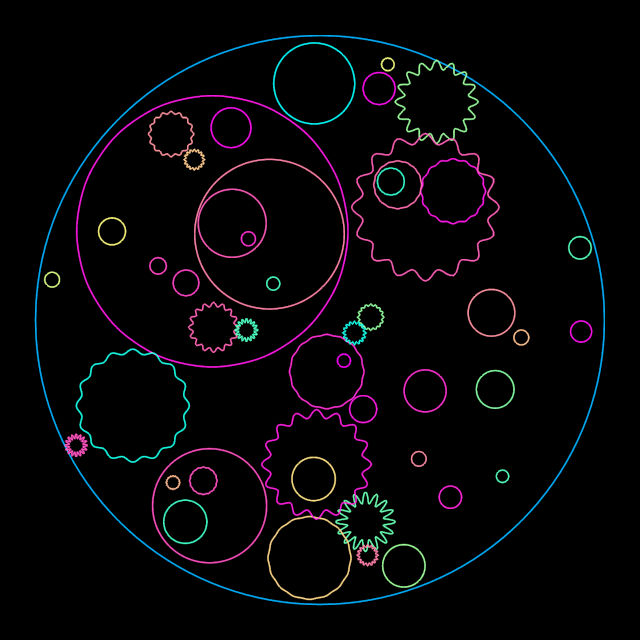# Bowntz
An audio-visual pseudo-physical simulation of colliding circles.
Originally implemented in Haskell using SuperCollider3 in 2010, ported to C and extended in 2023: blog post.
# 1 Examples
Ten video files on archive.org.
# 2 Notes
The world is a collection of N circles which each move at a constant speed in a straight line (in the absence of collisions). Given two such circles it is possible to calculate the precise time of their next collision. For N circles, O(N2) such “next” collisions may occur.
Pick the soonest next collision between circles A and B. This collision will change the velocities of A and B, but no other circle. Update the collection of collisions, by removing all the other “next” collisions involving either A or B, and computing the new collisions of A and B with all the other circles (O(N) collisions). For maintaining a consistent time-base for all circles in the world, it makes sense to advance in a straight line each circle to its position at the time of the collision.
Given a world at time T, to find the world at time T+dT simply step through the future collisions one by one until the soonest collision is after T+dT, at which point one can just advance the circles in straight lines to T+dT.
T T+1 T+2 T+3 T+4 T+5 T+6 T+7
... | | | | | | | | ...
----*---*---*---------*---------------**-*--*-*-------*------*--
Care needs to be taken in case of numerical imprecision: one can get an infinite number of collisions without time increasing.
# 3 Todo
-
adjustable audio/video offset for synchronisation
-
don’t hard-code 60fps display
-
web browser based version using Emscripten
-
for exhibition installation using an old laptop:
-
disable keyboard input (apart from power button)
-
disable trackpad input
-
disable magic SysRq key
-
shut down when mains power unplugged to preserve battery
-
-
for exhibition installation using a Raspberry Pi:
-
use TV/composite analogue A/V out to a 4:3 CRT
-
may require aspect ratio tweaks to ensure circles are circular
-
# 4 Code
git clone https://code.mathr.co.uk/bowntz.git
# 4.1 C Version
bowntz.c is the current C version (2023).
Build with make, run like ./bowntz.
Command line arguments:
-
--seed=42set pseudo-random number generator seed. -
--record=1render a video. -
--fs=1start in fullscreen mode, toggle with F or F11 keys.
Close window or press Q or ESCAPE keys to quit (not operational when record mode is active).
# 4.2 Haskell Version
bowntz.hs is the original Haskell version (2010),
which may be hard to get working as Haskell ecosystem changes fast.
Build with the cabal-install tool.
To run you need to start SuperCollider3 first:
$ scsynth -u 57110 &
-- wait for scsynth to start, connect its JACK ports --
$ ./bowntz
Bowntz requires a “clean” SC3 server to be running on its usual port. Bowntz leaves this SC3 server in an “unclean” state when it exits.
# 4.3 Legal
Source code is licensed under AGPL-v3-only.
Output is licensed under CC BY-NC-SA.
